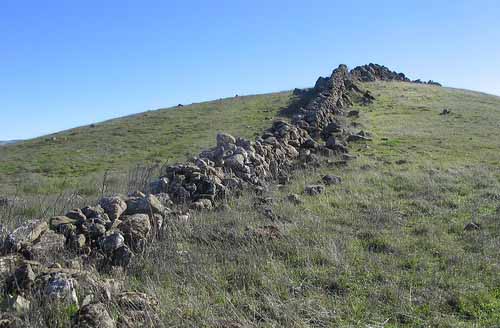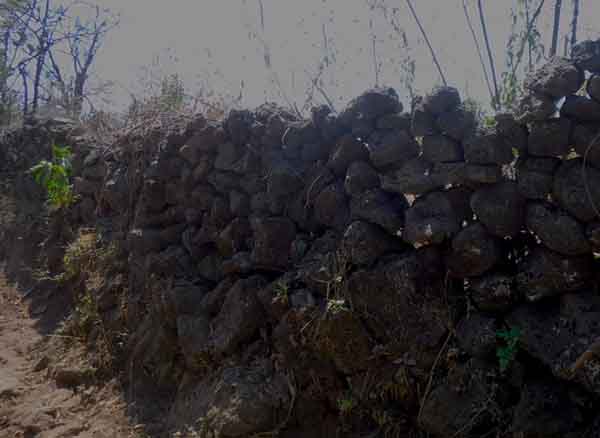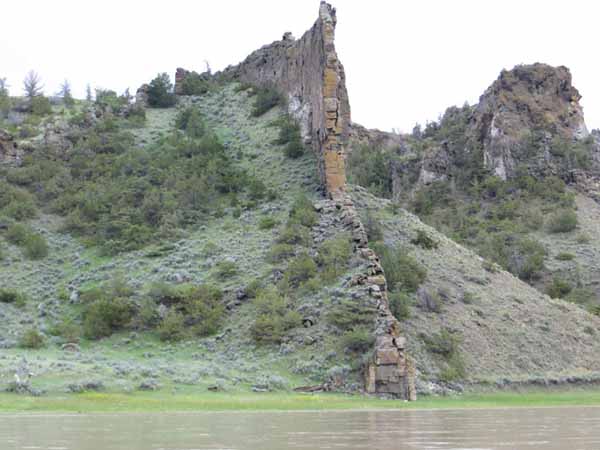Mysterious Rock Walls

East Bay Mysterious Rock Walls are also known as the Berkeley Mystery Walls. These crude, stone walls are located in the San Francisco Bay Area in California. In places, they are up to a meter high and a meter wide; the walls run in sections anywhere from a few meters to over a half mile long. The rocks used to construct the East Bay Walls are a variety of sizes. Some are basketball-sized rocks, while others are large sandstone boulders weighing a ton or more. Parts of the wall seem to be just piles of rocks, but in other places it appears the walls were carefully constructed. The exact age of the walls is unknown, but they have an old appearance. Many of the formations have sunk far into the earth, and are often completely overgrown with different plants. The purpose of these walls is still unknown. Since the wall is not continuous and is composed of multiple sections, they could not have been used as a fence. They are not tall enough to have been used as defense mechanisms. The walls function is unknown as well as the constructors. The East Bay Walls are accessible in several area parks, including Ed R. Levin County Park in Santa Clara County and Mission Peak Regional Preserve in Alameda County. The walls are found in the east bay of San Francisco.
The Real, True Story of the Mystery of the East Bay Walls | Bay Curious
East Bay Rock Walls and Alignments
There are many crude walls throughout the hills surrounding the San Francisco Bay Area. In places, they are up to a meter high and a meter wide and are built without mortar.The walls run in sections anywhere from a few meters to over a half mile long.
The rocks used to construct the walls are a variety of sizes. Some are basketball-sized rocks, while others are large sandstone boulders weighing a ton or more. Parts of the walls seem to be just piles of rocks, but in other places it appears the walls were carefully constructed.The exact age of the walls is unknown, but they have an old appearance.
America Unearthed: Ancient Ruins Discovered in California (S3, E7) | Full Episode | History
Berkeley Mystery Walls, Fremont, California
Neither Spanish settlers nor anyone since has been able to tell who built these strange California rock walls. There are remnants of ancient stone walls all over the East Bay, and no one knows how old they are, who built them, or why. Though people have been pondering the enigma of the Berkeley Mystery Walls for well over a hundred years, no conclusions have been reached, and despite wild speculation, no serious scholarly study has ever been undertaken.
Dikes and Sills
Visually, a dike looks like a natural wall of stone, sort of like a dam – or dike. A sill appears on a hillside or cliff face as a horizontal band of stone, like a window sill. Since both dikes and sills are originally of subterranean origin, some sort of regional uplift and/or erosion must have taken place to expose them at the surface. However, the East Bay Walls are definitely sandstone and full of shell fossils, so not volcanic by any stretch.

Walls of Rock
I’m assuming many of the walls – there are miles of them in total around here – are put up by families, not someone making a solo effort. The work must be dangerous: to drop a heavy rock, or have it topple after it’s positioned, can easily be a bone-breaking event. Up on the trails, I’m conscious that a twisted ankle or a sprained knee would mean a painful hobble to get help, but having 120 pounds of lava fall on my foot would be a whole other problem.So, I tip my straw hat to the guys who can construct and maintain these things. The walls are often a guide to the route I need to take, and they also indicate the long, long heritage of land cultivation around here.

Grand Natural Wall in Montana
It is easy to see how these walls are formed and broken down by erosion by looking at the Grand Natural Wall on the Eagle Creek in Montana, the biggest of many igneous “dikes” that formed within sandstone cracks millions of years ago. This “wall-like” appearance is quite common along this stretch of the river. Millions of years ago, during active volcanic periods, dark molten material was forced into cracks in the sedimentary rock. Over time the molten material solidified and subsequent erosion of the surrounding softer rock exposed the dark igneous walls you see today.
Mystery Walls – Bison Weirs?
The Spanish settlers in the area reported that the walls were already there when they arrived, and when they asked the local Ohlone American Indians, they said the same thing. Some think ancient Chinese navigators would have built the walls, but there would have had to have been thousands of them here well before the Ohlone Indians and over 10,000 years ago. However, the walls were the only structure left, which would have been odd for a civilization that knew how to build from stone.
Stone walls at Ed Levin County Park
Arlene, a local hiker, asked me about the stone walls at Ed Levin County Park. She said she’s been to the park but hasn’t seen the walls. Perhaps she’s among the sane folks who avoid hiking to the heights behind Ed Levin’s Sandy Wool Lake — the summits require 2,000 feet of climb in 3.9 miles, most of it unshaded and wind-blasted. The insane, like yours truly, have enjoyed the benefits of gazing upon these these interesting piles of stone.
To reach the walls you have to hike to the Monument Peak summit, about a quarter mile from the intersection of the Monument Peak and Agua Caliente trails. Either trail is a major slog, but the Monument Peak Trail is a little bit easier.
Unravelling the Mystery Behind the East Bay Walls: Who Really Made Them and Why?
In the hills around East Bay and elsewhere near San Francisco, there is a series of stone walls that extend discontinuously for miles. The walls are about 3-4 feet high in most places and are not enclosed. There is also no record of them being built or who might have built them.
New England Is Crisscrossed With Thousands of Miles of Stone Walls
Notice how farmers in the 1800s and earlier built stone walls out of rock debris in their fields. A lidar map on this site shows how each field was enclosed by a small square or rectangle of these discarded rocks, never in long, unenclosed areas. They were built from the ground up, never buried like our Mysterious Walls. Usually the remains of a farmhouse can be found nearby to these New England walls. No buildings or foundations have been found near the walls in our hills.
Sheep Jumping Fence
Including this to show how even sheep can manage to get over a wall made of sticks about 4′ high. Why would anyone try to contain wild game like elk or deer or farm animals like cattle or sheep with low rock walls? I can see how maybe more modern people saw these already half built walls, and reengineered them for their own purposes, such as hiding behind when hunting.
The Character and Function of Ancient Chinese Walls and Fortifications
Early Chinese were building huge, wide walls for fortifications against enemies and against flood waters. They were very good at constructing such walls, and they worked as they expected. They were not randomly piled rocks. Our walls are up in mountains and none are near rivers that need diverting, which they wouldn’t work for anyway. And if the walls were built for defense, defense against whom?
More about Ancient and Medieval History in the South Bay Area
